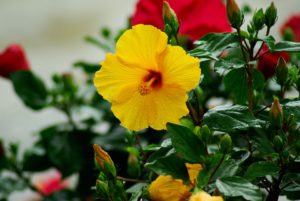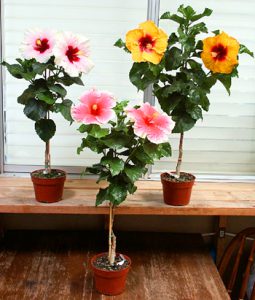Hibiscus Indoor Care Guide

Hibiscus is a tropical shrub that is grown on a wide scale because of its beauty, ease of growth, and its low maintenance. I have worked with many species on garden and landscape project and have seen the flavor these plants brings once use as a part of your garden design. Although hibiscus is popular for being grown outdoors the question is can hibiscus be grown indoors or as a house plant?
After all, these tropical beauties are seen growing in so many home gardens even commercial landscapes and garden designs. The hibiscus plant is native to warm temperate and tropical regions, there are said to be more than “200 species of hibiscus worldwide, each variety different in shape, color and size”.
The Hibiscus plant is a genus of flowering plants in the mallow family, Malvaceae, depending on the variety or species these tropical plants can get anywhere from 3 ft tall (dwarf variety) up to about 13 ft with 2-4 ft spread. What I love about the hibiscus plant is that it can be grown as a shrub, hedge, or standard plant. These garden beauties attract wildlife such as hummingbirds and many types of butterflies so if you are planting a wildlife garden or just want to give nature a helping hand by providing a food source (nectar) then consider installing some hibiscus.
But the question is still asked can a hibiscus be grown indoors? I am so happy that you asked, the answer to your question is yes, if your desire is to bring nature indoors with lots of beautiful colorful flower blooms then continue reading to see how it’s done.
Growing Hibiscus Indoors
The Container Size
The container is so important in order for your hibiscus to survive, the container that’s chosen should be large enough for the root ball of your hibiscus to sit comfortably. For example, if you’re growing a 3 gal hibiscus the container preferably a decorative container should be a 5 gal container. If you’re leaving your hibiscus in the grower’s pot then make sure that the grower’s pot has holes for water drainage to avoid root rot.
What I prefer is that both the grower’s pot and the decorative container have drain holes that is if using both pots is your desire because some people would rather place the grower’s pot inside of the decorative pot. Whatever methods you used make sure that both pots are slightly larger to accommodate the plant’s root ball.
Affiliate Disclaimer
As the owner of this website and Amazon Associate, I’ve tracked down Special Deals for some of the products mentioned here. When you use the links on this page to make a purchase I may get a small commission and you will get a great bargain. It’s a WIN-WIN for both of us.
The Soil Type
Hibiscus prefers soil that’s moist and well-drained, loam and sandy loam soil is ideal for your hibiscus to thrive. Adding organic matter will also help in conditioning the soil. Avoid saturating the soil, because soils that are waterlogged can and will lead to root rot.
Hibiscus Lighting Condition
Because hibiscus are tropical plants, they need lots of sunlight to thrive and to produce beautiful flower blooms, locate the sunniest place that gets the most sunlight and place your hibiscus there. A south or west-facing window is the ideal spot, this spot especially during wintertime is so important.
During the spring and summer months which is the hottest time of the year move the hibiscus somewhat away from the window during the hottest hour of the day. Remember however no matter the time of year hibiscus must have bright light to bloom and to grow healthy. If direct lighting from the outside is a challenge then providing artificial lights such as grow lights will help greatly.
Hibiscus Watering Methods

Ensure that the soil of your hibiscus is moist at all times and not waterlogged, the soil can be checked for the level of moister with a soil probe or moisture meter. If the soil is allowed to dry out completely the leaves of the hibiscus will wilt along with the loss of flower buds, leaf drop will also occur because of a constant lack of water. Another reason why the leaves will wilt is because of root-bound, if your hibiscus is root-bound then transplant it to a slightly larger container along with the soil type that we discussed earlier.
Hibiscus Fertilizing Methods
Hibiscus are heavy feeders there for a 10-5-20 fertilizer during the growing season which is spring through summer is the ideal time. Fertilize every 2 weeks with a liquid feed fertilizer or with a slow-release fertilizer every 8 weeks. Also, read the manufacturer’s label on the fertilizer bag before applying.
Hibiscus Garden Pests
Garden insect pests can place a damper on your efforts if these garden pests are not brought under control, if spotted on your hibiscus plant don’t panic. These uninvited guests are aphids, spider mites, and mealybugs. To minimize garden insect pests make sure that your hibiscus is getting the right amount of lighting and air circulation. But if after all of your efforts of meeting your hibiscus requirements and these garden pests still, show up then apply insecticidal soap which will offer help. Before applying soap spray read and follow the manufacturer’s label for the best results.
Disease of Hibiscus
The main issue when growing container-grown plants in most cases is overwatering which can lead to root rot, before watering your hibiscus check the soil level with a soil probe or moisture meter to determine if water is needed. As a rule, water only when the soil is slightly dry.
Hibiscus Indoor Temperature
The inside temperature should always be above 50˚C (10˚C), during the summertime refrain from locating your hibiscus outdoors. But once the temperature gets and remains above 50˚C (10˚C) you can now move your hibiscus outside.
Hibiscus Indoor Humidity
Keep your hibiscus from the dry air, dry air contributes to bud drop, leaf yellowing, and garden insect pests, during hot periods. To keep the humidity at the right level for your hibiscus installing a humidifier or humidity tray will help greatly, especially during the winter months.
Pruning/Pinching Indoor Hibiscus
In order for your hibiscus to produce an abundance of beautiful healthy flower blooms you must pinch or prune them, hibiscus produces flowers at the branch tip. Don’t hesitate to prune your hibiscus, pruning will remove some of the flowers but this is good for your hibiscus because if you don’t prune hibiscus will become overgrown.
The good news however is growing these tropical beauties indoors does not require as much pruning as growing them outdoors. Once or twice a year prune one-third of the selected crowded branches, this action will give you a fuller plant with lots of flowers.
Reporting Indoor Hibiscus
Although you should give your hibiscus root ball Rome to grow, the container should be slightly larger because a hibiscus blooms best when they are a bit underpotted. Repotting in a larger pot should be considered every 2 to 3 years. The ideal time to repot is late winter ( late February or March). A good potting soil mix is ideal when repotting your hibiscus.
The final word on growing hibiscus indoors
There you have it, the hibiscus plant is so easy to grow and care for indoors, these garden beauties will not only help you to connect with nature in your indoor living space but will beautify your interior. I love the hibiscus plant because of its beauty and the abundance of flower blooms they produce so go ahead and give this tropical beauty a try you will be so happy with the results as your interior get that added flavor with the hibiscus plant.
About the author
Norman loves being in the garden, both at home and for his job....
he is 'Natures Little helper' being outdoors, growing his vegetables and flowers from an early age.
Now having spent over 22 years in the profession he want to give some of his knowledge to others...
his vast array of hints and tips you will find scattered over this site will help you no end growing plants in your garden.

Hi, Norman. First of all, thank you for creating this great article about Hibiscus Flowers. I didn’t know about this until I read your article. I’m thinking of putting these hibiscus flowers in my office. Is it hard to maintain it in an office environment? I once tried to raise a flower but due to lack of maintenance the flower dies within a week ;(
Hello, sugiya so happy to meet you, now as far as growing plants indoors it’s all about getting the right information to have success. Once you follow the instructions in this post you will have success by growing the plant hibiscus indoors.
Some plants are low maintenance and easy to care for and then there are some that are considered to be high-maintenance needing more attention. Probably the flowering plant that you bought was high maintenance but also know if a plant is low maintenance they still need some tender loving (maintenance) care.
I am so happy to help and I hope this helps, all the best to you and please let me know how it goes.
https://gardenofedengardencent…
I have not grown anything indoors before. However, you really know your stuff when it comes to the soil watering methods and fertilizers that need moderate distribution. Your recommendations helped me and my neighbor start working on our lawn. I still do not know how to handle the potted palm tree. I believe you would be the guru with the green thumb to ask. I actually learn something about the hibiscus that I never knew so I am excited to read this article. I do not like to open my doors in weather below 75 degrees and I do not use AC below 68 degrees. In fact, I use the natural weather temperature until temperatures in my house until the temperature goes outside of the 68 – 84 degree range. Now that I think about it a Hibiscus would enjoy my lifestyle.
Thank you for your kind words and as always I am so happy to help wherever I can, whatever your questions are concerning potted palms you can always drop me an email. Hibiscus are amazing tropical plants and do work wonders to bring that flavor. Wishing both you and your neighbor much garden success with your project and please let me know how it goes. Have a good day!